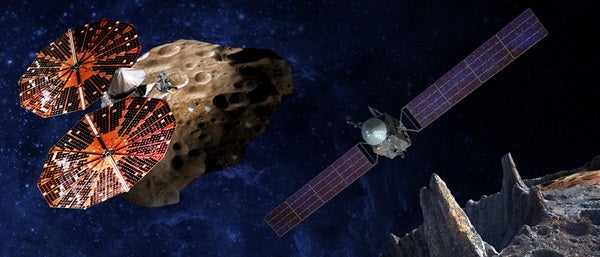Our modern-day solar system is a result billions of years in the making. Unfortunately, rewinding time to witness the formation of the solar system is out of the question. To determine our solar system’s origins, astronomers instead study “planetary leftovers” for clues about the makeup of the original solar nebula around our infant Sun. NASA’s newest Discovery-class missions, Lucy and Psyche, will provide valuable insight into the past lives of the planetary building blocks that share our local neighborhood.
Asteroids represent a vital part of our solar system’s fossil record. Uncovering their secrets will further astronomers’ understanding not only of how our own solar system formed, but how planetary systems form around stars throughout the galaxy as well.
The newest missions to receive NASA Discovery Program backing will study these fossils in greater detail. Lucy, set to launch in 2021, will examine both a main belt asteroid and six of the Trojan asteroids that share Jupiter’s orbit around the Sun. According to Harold F. Levison, the mission’s principal investigator and a researcher at the Southwest Research Institute in Boulder, CO, “the Trojans … hold vital clues to deciphering the history of the solar system.” This is because astronomers believe that the Trojans may have formed much further out in the solar system, and only settled into their current orbits once they were captured by Jupiter’s gravity. The mission is named after the famous 3.2 million-year-old Lucy fossil to highlight the Trojans’ potential for revolutionizing our understanding of the early solar system.
Psyche, launching in 2023, is set to encounter its namesake, the asteroid 16 Psyche, in 2030. Unlike the majority of asteroids found in the main belt, which are icy or rocky, the 130-mile (210 km) wide 16 Psyche is metallic, comprised largely of iron and nickel. With a makeup so unlike its neighboring asteroids and so similar to the Earth’s core, astronomers wonder whether 16 Psyche could be the remnants of an early protoplanetary core that has lost its outer rocky layers via collisions. Psyche’s principal investigator, Lindy Elkins-Tanton of Arizona State University, hopes the mission will shed light on this unique solar system object and help scientists understand how planetary bodies separate into layers over time. Currently, Psyche’s mission plan includes a 20-month mission duration once the spacecraft reaches its destination to map the surface and study its properties.
The data gathered by Lucy and Psyche will add to the ever-sharpening picture of asteroids that other missions such as NEAR, Dawn, and OSIRIS-REx are designed to provide. According to Jim Green, NASA’s Planetary Science Director, “These additional pieces of the puzzle will help us understand how the sun and its family of planets formed, changed over time, and became places where life could develop and be sustained – and what the future may hold.”
NASA’s Discovery Program has been in operation since 1992. Designed to promote missions that complement NASA’s largest “flagship” projects while focusing specifically on solar system science, the Discovery Program consistently launches smaller, less expensive spacecraft with shorter turnaround times. Discovery mission budgets are capped at $450 million, but their “smaller” budgets have in no way limited these missions’ contributions to planetary science. Some of the program’s most famous missions include Lunar Prospector, Stardust, Mars Pathfinder, MESSENGER, and Kepler. The Discovery Program’s core directive also emphasizes education and outreach, bringing the excitement of solar system science and discovery home to the public.










